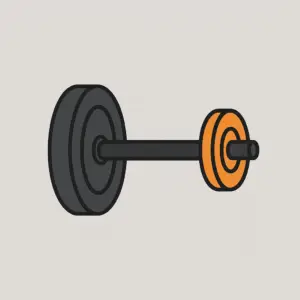
Heavy vs Light: The Load Debate Revisited
There’s a classic 2012 study by Mitchell et al. published in the Journal of Applied Physiology that challenged a long-held belief in strength training — that you must lift heavy to build muscle. The researchers found that lifting lighter weights to fatigue produced similar hypertrophy (muscle growth) as lifting heavier ones to the same level of fatigue.
That finding has stood the test of time. Since then, multiple meta-analyses have confirmed that it’s not the load itself, but how close you get to fatigue that matters most for muscle growth.
What the Evidence Says
Schoenfeld et al., 2017 – A meta-analysis showed that when sets are taken to failure, muscle growth is similar across low- and high-load training. Heavier loads do tend to produce greater strength gains, but hypertrophy responds mainly to effort rather than weight.
👉 Read summary on J Strength Cond ResGrgic et al., 2020 – Looking deeper at muscle fibers, this review found no significant difference in growth between type I and type II fibers when comparing light vs heavy loads — again, as long as sets went to failure.
👉 Read on PubMed CentralSports Medicine Open Review, 2023 – Loads under 50 % of one-rep max (1RM), when performed near failure, can match heavier loads for hypertrophy and strength adaptations, especially in less trained or rehab settings.
👉 Read open access articlePedrosa et al., 2021 (Sports) – A systematic review titled “Loading Recommendations for Muscle Strength, Hypertrophy, and Local Endurance” proposed a new paradigm: hypertrophy can occur across a broad spectrum of loading zones, not just the so-called moderate-load “sweet spot.”
👉 Read open access article
What This Means in Practice
Effort trumps load. Muscle growth depends on training close to failure, not just lifting heavy.
Load is a variable, not a rule. Choose what your joints, energy, and recovery can handle.
Heavy loads for strength, lighter loads for safety. Both have their place, depending on your phase, focus, and fatigue levels.
Consistency and control matter. Especially when you’re rebuilding after time off, injury, or illness.
In short: the science has been telling us for more than a decade that you don’t have to go heavy to get results — you just have to go with intent.
Related posts:
- (archive)Opening up in a time of Lock-Down I thought it might be worth penning a few lines to clarify the situation within the world of hands-on therapy for my dear cherished clients and friends that I work with in these strange strange times. I’m in lockdown, as we all are, and I’m respecting the government guidelines, which...
- Pilates, posture and movement Over 2021 I had the opportunity to expand the repertoire of exercises that I can offer my clients by studying with the Australian Physiotherapy and Pilates Institute. This was demanding, sometimes exhausting but always great fun! In teaching these exercises to my clients I have found that there are a...
- 2022 Price Changes Bookings made from January 2022 onwards will be subject to a minor price change. 1 hour Massage sessions £50 First Appointment and 75 minutes Massage £55 Hot Stones (1 Hour) £55 Reflexology First Appointment £45 Reflexology Subsequent Appointment £40 Pilates 1-2-1 £45...
- Safety and Precautions I wanted to reassure all my clients that I am running my clinic mindful of our present Covid situation, and am tending to err on the side of caution. Mask wearing, PPE, cleaning, rapid flow testing, ventilation and use of a HEPA/UVC filter (homedics) continues as it has since I...
